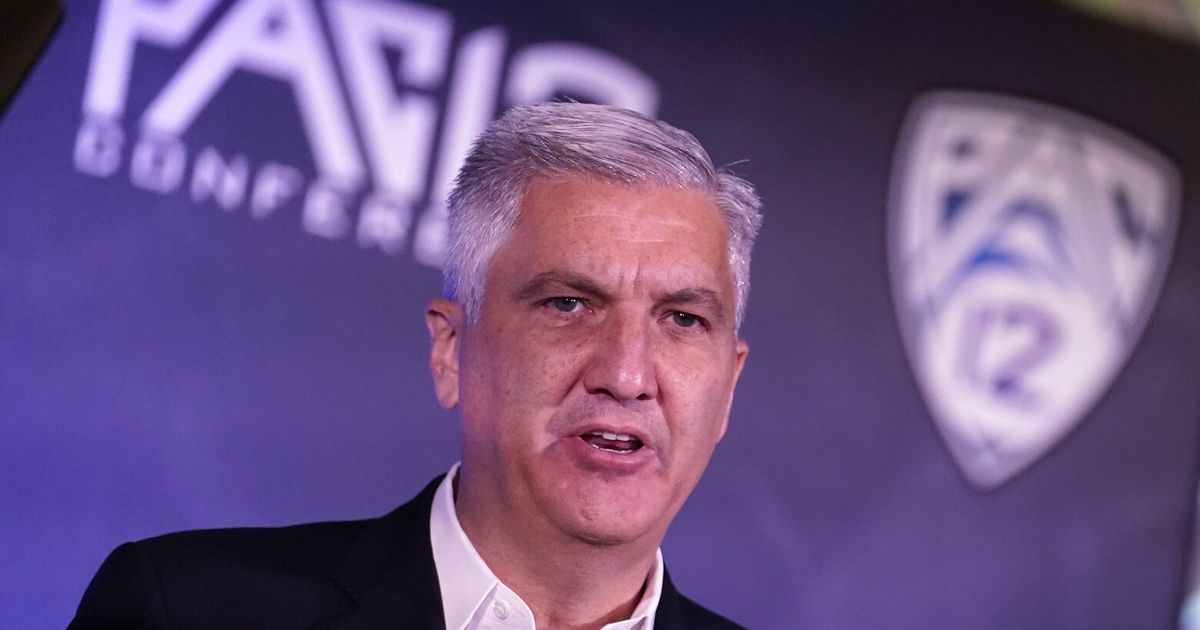
The Pac-12 presidents joined commissioner George Kliavkoff and conference executives on Monday at Arizona State for the conference’s quarterly meetings. The agenda featured a plethora of weighty issues, none more important than the state of the media rights negotiations.
For all the focus on the media rights themselves — that is, the underlying value of Pac-12 football and basketball — not enough attention has been placed on the third word in that oft-repeated phrase: negotiations.
Those are occurring on several levels.
— Kliavkoff has regular discussions with representatives from ESPN, Fox, Amazon and other media companies about valuations, packages of games, the weekly selection order and kickoff days and times.
— Within the conference, there are negotiations (in a loose, informal sense) about the type of media deal that works best. How much emphasis should be placed on chasing revenue? How much on maximum visibility? The ideal media contract for one school might not sit perfectly with another.
— Even inside the Pac-12 boardroom, there is a hierarchy that must be managed and navigated: The presidents’ highly influential executive committee, featuring Stanford’s Marc Tessiere-Lavigne, Washington State’s Kirk Schulz and Washington’s Ana Mari Cauce (the chair), steers the agenda and works closely with Kliavkoff on strategy.
As with all negotiations, the goal is to aim high but know the market. That’s not always easy, and in the Pac-12’s case, the market has shifted over time.
Last summer, when the conference began pursuing a media rights agreement following the thunderbolt from Los Angeles, the Big Ten’s massive deal created a valuation ceiling.
The Pac-12’s rights aren’t worth nearly as much, but Kliavkoff could draft off the Big Ten’s $1 billion annual deal: “If they are worth X, then we are worth two-thirds of X” — or something to that effect.
And in theory, the Big 12 would do the same when it went to the market with a reconfigured membership that did not include Texas or Oklahoma.
After all, the two leagues are similar in valuation: The Pac-12 has better media markets and the two top football brands (Washington and Oregon), while the Big 12 has better competitive depth and a superior basketball product.
As the realignment waters settled and it became clear the Big Ten wasn’t adding more schools, the Hotline pegged valuation ranges for the Pac-12 and Big 12 as the following:
— Pac-12: $35 million to $40 million per school per year
— Big 12: $38 million to $42 million per school per year
But then the landscape changed, dramatically. The Big 12 prioritized security over cash, opting to renew its partnerships with ESPN and Fox instead of waiting a year to hit the open market.
The resulting seven-year deal, reportedly worth $31.7 million per school per year, made sense given the league’s tumultuous past. But it undercut the Pac-12’s negotiating position.
Whereas the Big Ten’s deal had served as a valuation North Star for the conference, the Big 12’s agreement became its Southern Cross to bear.
ESPN, Fox, Amazon and the other media companies with varying degrees of interest in partnering with the Pac-12 could use the Big 12’s deal as the relevant comparison, thereby driving down the price.
Whether that price is $2 million more annually (per school) or $2 million less doesn’t matter. The difference isn’t transformative either way.
(By renewing its deal with the Big 12, ESPN positioned itself to get two conferences on the cheap. The house always wins.)
That said, it was unrealistic to expect the Pac-12 to finalize a deal in the early-to-mid fall. The Big Ten, which also sought new media partners on the open market, required approximately six months to complete its deal. There was nothing to suggest the Pac-12 would work on a substantially condensed timeframe.
And we understood Kliavkoff’s desire to wait for UCLA’s fate to play out with the University of California Board of Regents, a highly politicized process that dragged into the middle of December. The likelihood of a reversal was always ultra-slim, but the board’s unpredictable nature, combined with the massive stakes, justified the delay.
Admittedly, the Hotline erroneously presumed a deal was close at that point — that once the regents sent UCLA on its merry way to the Big Ten, the Pac-12 would finalize its media partnerships in the window before Christmas or the first half of January.
It’s now late January, and there is no deal.
Which brings us back to the art of negotiating and risk recognition.
Waiting creates a void, a standing invitation for the unknown to alter the trajectory of the negotiations and the future of the conference.
Perhaps the marketplace will shift in favor of higher valuations — after all, the Pac-12 is the only Power Five conference with inventory available. (Everyone else is locked up until the 2030s.) Perhaps new suitors will enter the fray.
Or, maybe, the economy will deteriorate. Maybe current bidders will grow weary of the Pac-12’s stance and either reduce their offers substantially or walk away altogether.
Had ESPN, Amazon, Fox, Apple, CBS — or a combination therein — made a killer offer, the Pac-12 board would have authorized Kliavkoff to accept.
The Pac-12 could keep pushing, it could keep attempting to draft off the Big Ten’s deal, but the Big 12’s valuation is the reality.
The market is set.
Any maneuverability is on the margins.
We expect the process to conclude by the middle of March. If that window comes and goes with no deal imminent, our outlook will take a turn for the worse.